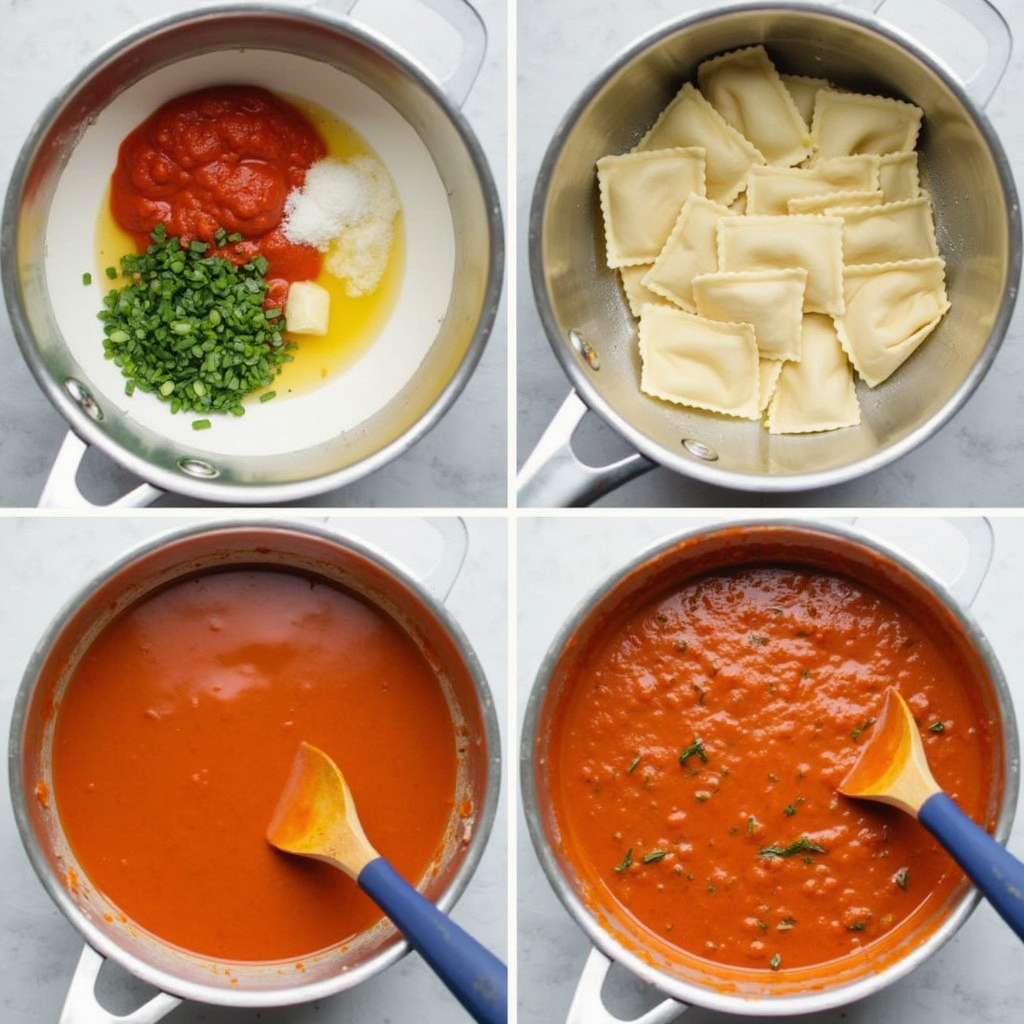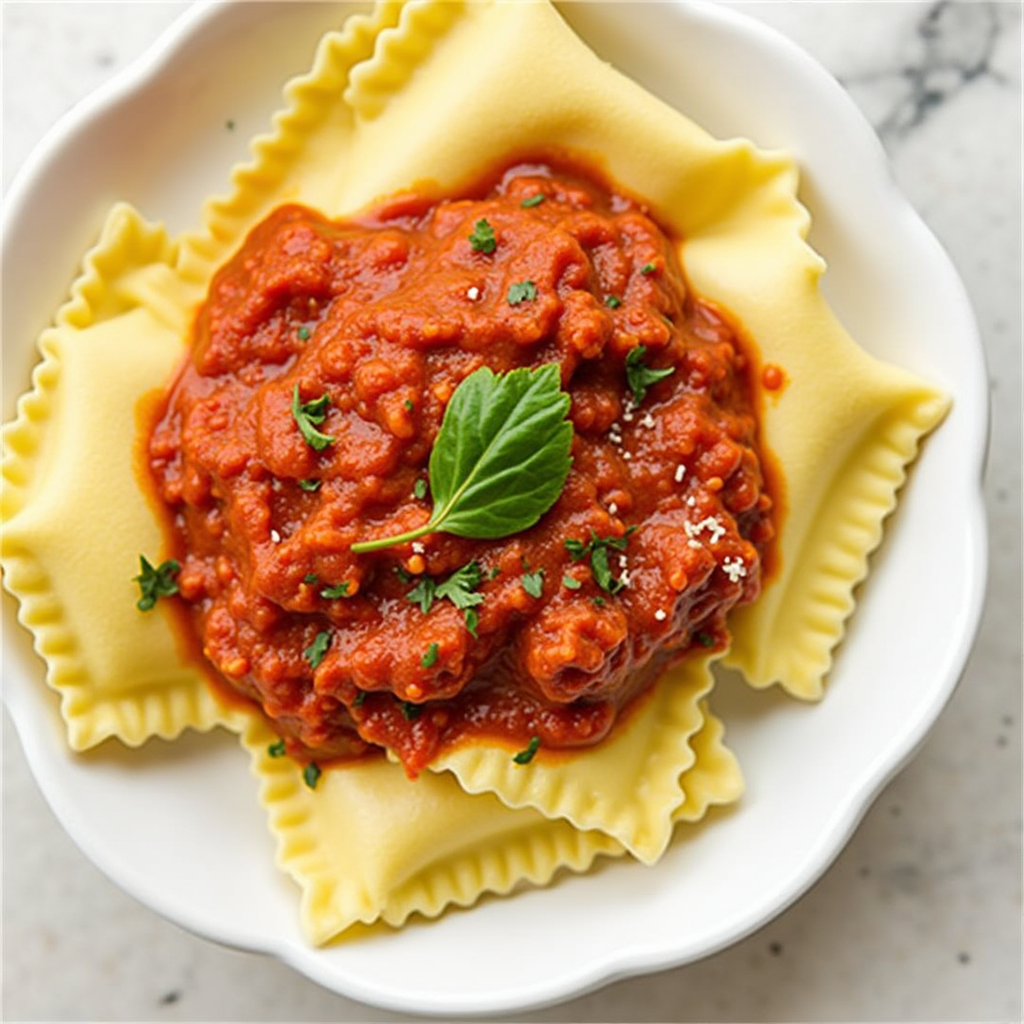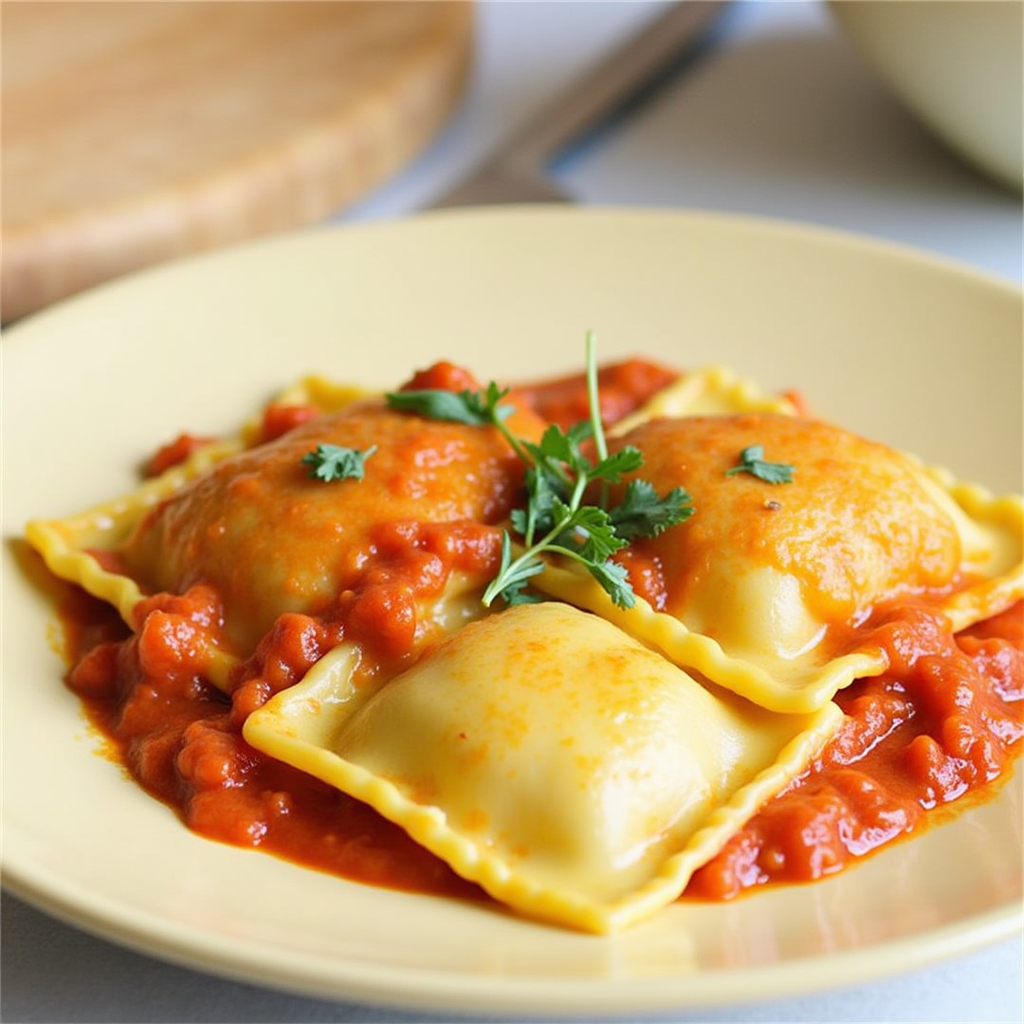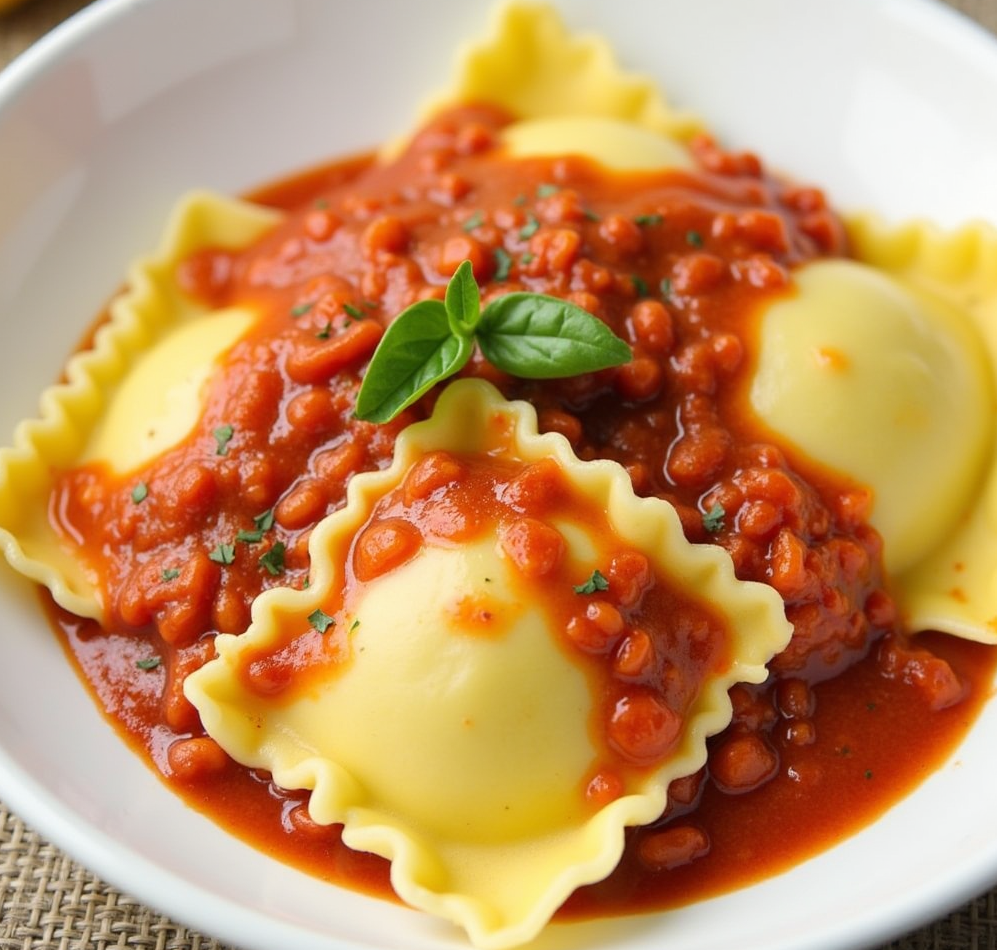A plate of ravioli is only as good as the sauce that complements it. Whether you prefer a rich, creamy texture or a light, herb-infused base, the right easy ravioli sauce enhances every bite. With a few simple ingredients and minimal effort, you can create a flavorful addition to homemade or store-bought ravioli.
Choosing the right sauce depends on the type of ravioli you are serving. Cheese-filled pasta pairs beautifully with tomato-based options, while mushroom or spinach-filled varieties shine with buttery or creamy sauces. Each recipe below ensures a perfect balance of texture and flavor.
This guide provides several easy ravioli sauce recipes that cater to different tastes. Whether you’re cooking for a casual weeknight dinner or a special gathering, these sauces will elevate your dish. Let’s explore why sauce selection is essential before diving into the recipes.
Why a Great Sauce Matters
A well-prepared easy ravioli sauce transforms a simple dish into a memorable meal. The right balance of flavors enhances the filling, ensuring that no ingredient overpowers the others.
The sauce you choose should complement the ravioli rather than compete with it. For example:
- A light, herb-infused sauce allows delicate ricotta-stuffed ravioli to shine.
- Creamy sauces add richness to hearty, meat-filled pasta.
- Butter-based sauces highlight earthy mushroom ravioli.
Additionally, texture plays a crucial role. A smooth tomato sauce coats pasta evenly, while a chunky vegetable sauce adds a satisfying bite. Temperature also matters—warm sauces bring out the flavors of both the pasta and filling.
By selecting the ideal easy ravioli sauce, you enhance every aspect of your meal. Now, let’s look at some classic and creative sauce recipes that pair perfectly with ravioli.
Classic Tomato Basil Sauce

Few sauces are as universally loved as a rich easy ravioli sauce made from tomatoes and basil. This simple yet flavorful option brings freshness and depth to any ravioli dish.
Ingredients:
- 2 tablespoons olive oil
- 3 cloves garlic, minced
- 1 can (28 oz) crushed tomatoes
- 1 teaspoon salt
- ½ teaspoon black pepper
- ½ teaspoon sugar
- 1 teaspoon dried oregano
- ¼ teaspoon red pepper flakes (optional)
- ½ cup fresh basil leaves, chopped
Instructions:
- Heat olive oil in a pan over medium heat. Add minced garlic and sauté until fragrant.
- Pour in crushed tomatoes and stir well.
- Add salt, pepper, sugar, oregano, and red pepper flakes, stirring to combine.
- Simmer for 15–20 minutes, stirring occasionally.
- Remove from heat and stir in fresh basil.
This easy ravioli sauce pairs especially well with cheese or spinach-stuffed ravioli. The acidity of the tomatoes balances the richness of the filling, while the basil adds an aromatic touch. If you prefer a smoother sauce, blend the mixture before serving.
Creamy Garlic Parmesan Sauce
For a decadent, restaurant-quality meal, try a creamy garlic parmesan sauce. This indulgent option creates a silky, flavorful coating for ravioli without overpowering the dish.
Ingredients:
- 2 tablespoons unsalted butter
- 3 cloves garlic, minced
- 1 cup heavy cream
- ½ teaspoon salt
- ¼ teaspoon black pepper
- ½ cup grated Parmesan cheese
- ¼ teaspoon nutmeg (optional)
- 2 tablespoons chopped parsley
Instructions:
- Melt butter in a saucepan over medium heat. Add minced garlic and cook until fragrant.
- Pour in heavy cream, stirring continuously.
- Season with salt, pepper, and nutmeg if using.
- Reduce heat and stir in Parmesan cheese until melted.
- Remove from heat and mix in chopped parsley before serving.
This easy ravioli sauce works best with mushroom, chicken, or cheese ravioli. The richness of the cream and cheese enhances the pasta without making it overly heavy. Serve immediately to enjoy the best texture.
Brown Butter Sage Sauce
A brown butter sage sauce is a simple yet elegant choice for ravioli lovers. The nutty, aromatic butter complements the pasta beautifully, making it ideal for both cheese and pumpkin-filled ravioli.
Ingredients:
- ½ cup unsalted butter
- 8 fresh sage leaves
- ¼ teaspoon salt
- ¼ teaspoon black pepper
- ¼ cup grated Parmesan cheese (optional)
Instructions:
- Heat butter in a skillet over medium heat until it begins to foam.
- Add sage leaves and cook for 2–3 minutes until the butter turns golden brown.
- Season with salt and pepper, then remove from heat.
- Drizzle over cooked ravioli and sprinkle with Parmesan if desired.
This easy ravioli sauce requires minimal effort but delivers maximum flavor. The sage provides a warm, earthy note, while the brown butter adds depth. Pair it with butternut squash or ricotta ravioli for an unforgettable meal.
Mushroom Alfredo Sauce
A velvety mushroom alfredo sauce brings richness and umami to ravioli dishes. This variation on traditional Alfredo sauce incorporates sautéed mushrooms for extra depth.
Ingredients:
- 2 tablespoons olive oil
- 1 cup sliced mushrooms (such as cremini or button)
- 2 cloves garlic, minced
- 1 cup heavy cream
- ½ teaspoon salt
- ¼ teaspoon black pepper
- ½ cup grated Parmesan cheese
- ¼ teaspoon dried thyme
- 2 tablespoons chopped parsley
Instructions:
- Heat olive oil in a skillet over medium heat. Add mushrooms and cook until tender.
- Stir in garlic and sauté for another minute.
- Pour in heavy cream, season with salt, pepper, and thyme, and bring to a gentle simmer.
- Stir in Parmesan cheese until smooth.
- Remove from heat and mix in chopped parsley.
This easy ravioli sauce pairs beautifully with spinach, ricotta, or meat-filled ravioli. The combination of creamy sauce and earthy mushrooms makes every bite satisfying. Serve hot for the best consistency.
Easy Ravioli Sauce: Spicy Arrabbiata and Pro Tips for the Perfect Dish

Spicy Arrabbiata Sauce
If you enjoy bold flavors, a spicy arrabbiata sauce is the perfect way to add heat to your ravioli. This fiery tomato-based sauce delivers a satisfying kick while maintaining a balance of acidity and sweetness.
Ingredients:
- 2 tablespoons olive oil
- 3 cloves garlic, minced
- 1 can (28 oz) crushed tomatoes
- 1 teaspoon salt
- ½ teaspoon black pepper
- ½ teaspoon sugar
- 1 teaspoon dried oregano
- ½ teaspoon red pepper flakes (adjust to taste)
- ¼ teaspoon smoked paprika (optional)
- ½ cup fresh basil leaves, chopped
Instructions:
- Heat olive oil in a skillet over medium heat. Add minced garlic and sauté until fragrant.
- Stir in red pepper flakes and smoked paprika for extra spice.
- Pour in crushed tomatoes, then season with salt, black pepper, sugar, and oregano.
- Simmer for 15–20 minutes, stirring occasionally.
- Remove from heat and mix in fresh basil before serving.
This easy ravioli sauce pairs exceptionally well with cheese or beef-filled ravioli. The spice level can be adjusted to suit personal preference, making it a versatile option for those who love heat. Serve with a sprinkle of Parmesan to balance the bold flavors.
Common Mistakes to Avoid
Even the simplest easy ravioli sauce recipes can go wrong if certain mistakes are made. By avoiding these pitfalls, you can ensure a perfectly balanced sauce every time.
Overcooking the Garlic
Garlic burns quickly, turning bitter and overpowering the sauce. Always cook it over medium heat for just a minute before adding other ingredients.
Using Low-Quality Tomatoes
Since tomatoes are the base of many sauces, using fresh or high-quality canned varieties ensures the best flavor. Inferior tomatoes lead to a sauce that tastes overly acidic or bland.
Adding Too Much Salt at Once
Salt should be added gradually and adjusted as needed. Over-salting early on can make it difficult to fix the balance later.
Skipping the Simmering Process
Allowing the sauce to simmer for at least 15 minutes deepens the flavors. Rushing this step results in a sauce that tastes raw and unbalanced.
Not Adjusting the Consistency
Some easy ravioli sauce recipes may be too thick or thin. If it’s too thick, add a splash of pasta water. If too thin, let it cook down for a few extra minutes.
By keeping these tips in mind, your ravioli sauce will always turn out flavorful, well-balanced, and restaurant-quality.
Expert Tips for the Perfect Ravioli Sauce
Creating the ultimate easy ravioli sauce requires more than just following a recipe. These expert tips help bring out the best flavors and textures in your sauce.
Use Fresh Ingredients Whenever Possible
Fresh basil, garlic, and high-quality Parmesan enhance the overall depth of flavor. While dried herbs work in a pinch, fresh ingredients always provide a more vibrant taste.
Balance Acidity with Sweetness
Tomato-based sauces often have a naturally acidic profile. A pinch of sugar or a splash of balsamic vinegar helps create a smoother, well-rounded sauce.
Incorporate Pasta Water for a Silkier Texture
Adding a small amount of reserved pasta water helps the sauce cling to the ravioli. The starch from the water thickens the sauce while improving its consistency.
Layer the Flavors
Instead of dumping all the ingredients in at once, add them in stages. This technique ensures that each component develops its full flavor potential.
Finish with a High-Quality Olive Oil
Drizzling a bit of extra virgin olive oil over the finished sauce enhances richness and adds a hint of fresh aroma. This simple step makes a noticeable difference in taste.
By following these techniques, your easy ravioli sauce will have a professional touch, ensuring that every dish is both flavorful and satisfying.
FAQs
What is an easy ravioli sauce recipe?
A simple yet flavorful easy ravioli sauce can be made using just a few ingredients. First, heat two tablespoons of olive oil in a pan over medium heat. Next, sauté three cloves of minced garlic until fragrant. Then, pour in one can (28 oz) of crushed tomatoes and season with salt, black pepper, and a pinch of sugar to balance the acidity. Let the sauce simmer for 15 minutes, stirring occasionally. Finally, stir in fresh basil for a burst of flavor before serving. This classic tomato sauce pairs well with almost any ravioli filling and requires minimal effort.
Can I make my own ravioli?
Absolutely! Making homemade ravioli is easier than it seems. First, prepare a basic pasta dough using flour, eggs, and a pinch of salt. After kneading and resting the dough, roll it out into thin sheets. Then, place small spoonfuls of filling—such as ricotta and spinach—onto one sheet before covering it with another. Next, press around the edges to seal each ravioli and cut them out using a ravioli cutter or knife. Finally, boil the ravioli for 2–4 minutes until they float to the surface. By making your own ravioli, you can customize flavors and enjoy a fresher, more satisfying dish.
How long does it take to make ravioli sauce?
Most easy ravioli sauce recipes take 15 to 30 minutes to prepare. If you’re making a quick tomato basil sauce, you only need 15 minutes of simmering. However, for a richer flavor, a slow-cooked sauce may take up to 30 minutes. Meanwhile, creamy sauces like garlic Parmesan or Alfredo can be ready in as little as 10 minutes. Regardless of the type, using fresh ingredients and allowing the flavors to develop ensures the best taste in a short amount of time.
What is ravioli sauce?
Ravioli sauce is a flavorful addition that enhances the taste and texture of ravioli. Typically, it can be tomato-based, cream-based, or butter-based, depending on the type of filling inside the pasta. A classic easy ravioli sauce might include garlic, olive oil, tomatoes, and herbs, while a richer version could feature butter, cream, and Parmesan cheese. The right sauce not only complements the ravioli but also ensures a balanced, well-rounded dish.
Conclusion

A delicious easy ravioli sauce brings out the best in any pasta dish. Whether you prefer a spicy arrabbiata, a rich garlic Parmesan sauce, or a classic tomato basil combination, the right sauce enhances the flavors of your ravioli.
By avoiding common mistakes and following expert tips, you can create a well-balanced, flavorful sauce every time. Simple techniques like using high-quality ingredients, simmering for depth, and adjusting seasoning as needed make all the difference.
Next time you prepare ravioli, experiment with different easy ravioli sauce recipes to discover your personal favorite. No matter which option you choose, a homemade sauce will always provide a fresh and satisfying dining experience.

